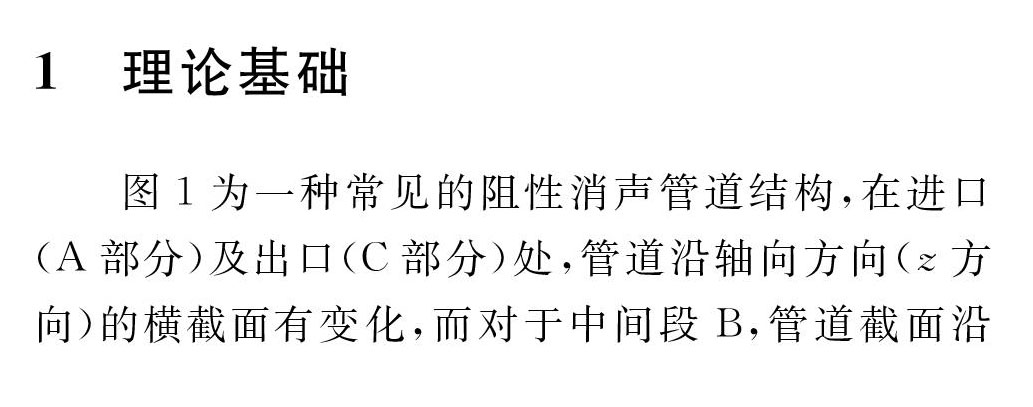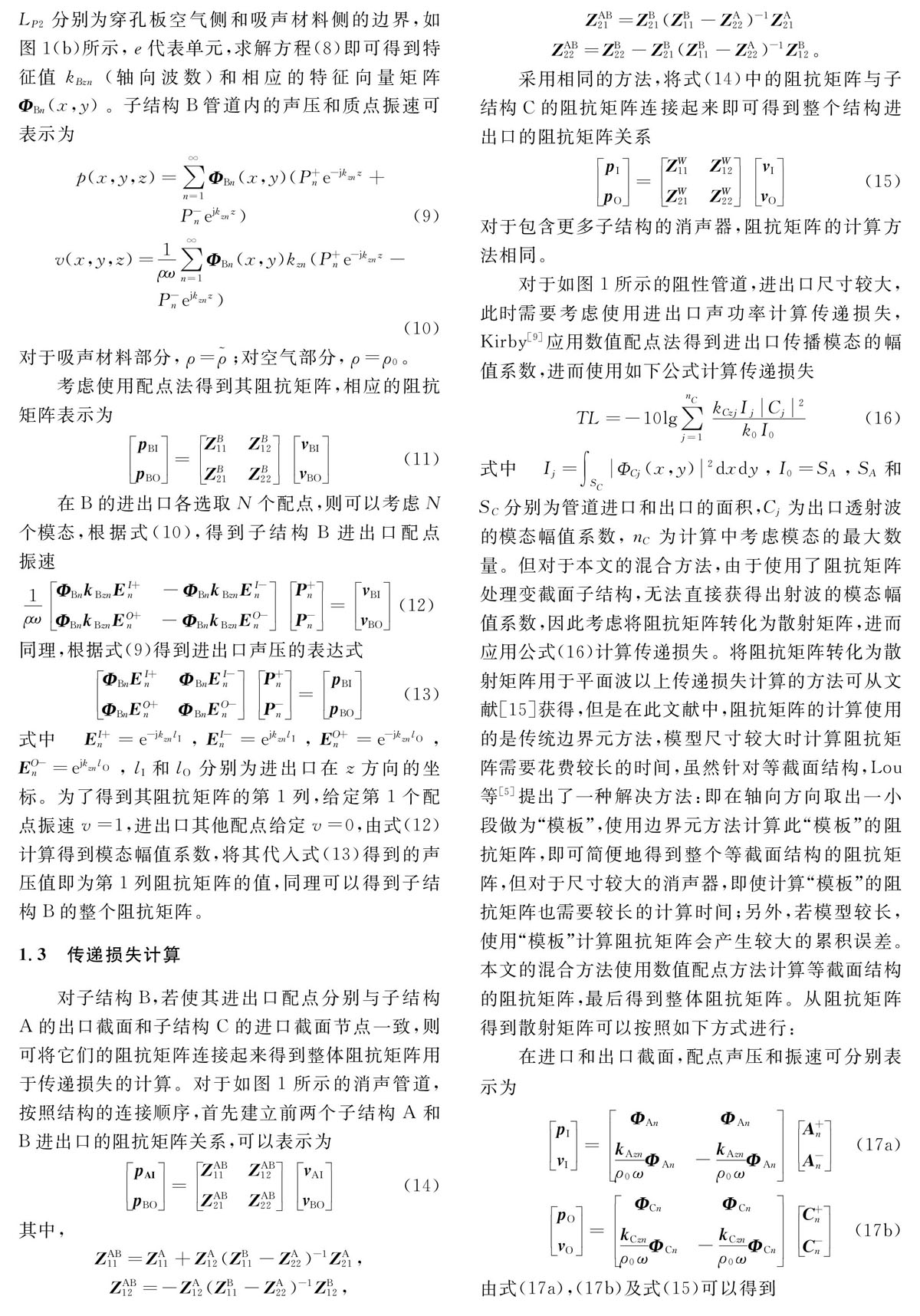阻性管道消声性能预测的边界元数值配点混合方法
杨亮 季振林



摘要: 将边界元方法与配点法结合形成一种混合方法用于大尺度阻性管道的声学性能预测,根据截面形式,整个结构被划分为若干子结构,边界元方法与配点法分别被用于计算非规则结构和规则结构的阻抗矩阵,最后将各阻抗矩阵连接起来用于传递损失的计算。由于管道进出口为非平面波传播,考虑对进出口配点进行模态展开,将阻抗矩阵转化为散射矩阵,使用进出口的声功率计算传递损失。通过与数值方法和实验值比较验证了方法的正确性,进而应用该方法对管道消声性能进行分析。关键词: 消声;传递损失;阻性管道;边界元方法;配点法
中图分类号:TB535; TB115.1文献标志码: A文章编号: 1004-4523(2016)03-0498-06
DOI:10.16385/j.cnki.issn.10044523.2016.03.016
引言
解析方法[1]和传统数值方法(有限元方法[2]和边界元方法[35])已经被普遍应用于消声管道的声学性能计算,解析方法计算速度快、精度高,但只适用于简单结构的传递损失计算。传统数值方法理论上可应用于任意复杂结构,但对大尺度声学问题会花费较多的计算时间和内存。因此,对于大尺度复杂消声管道(如燃气轮机进排气管道及大型暖通空调管道等)的计算方法需要进一步研究,目前,国内外学者主要从两个方面对此类问题进行了探索和研究:首先是对计算方法本身进行了优化,针对管道声学,Ji等[4]和Lou等[5]使用一种阻抗矩阵方法用于具有较长管道的消声系统的计算,近年来,快速算法[6]的出现也在一定程度上弥补了传统数值方法的局限性。另一方面,针对具体问题可以考虑结合数值方法的任意适用性和解析方法的快速准确性形成混合方法,进而实现大尺度问题的计算。Kirby[710]使用数值配点方法对消声管道进行了大量的研究,使用二维有限元方法提取管道截面的特征值和相应的特征向量,进而在一定的边界条件下应用配点法得到模态幅值系数。接着,Kirby[11]对配点法进行了改进,使用数值模态匹配方法对阻性消声器进行了研究,Fang和Ji[1213]使用该方法对抗性消声器和考虑运流效应的阻性消声器进行了分析。数值配点法适用性更强,适用于具有较为复杂结构管道[8]的声学性能计算。以上介绍的混合方法都是针对沿结构轴向方向具有一致截面的消声器或者消声管道,在实际应用中,变截面管道是较为常见的,此时如何应用混合方法实现大尺度问题的快速计算值得进一步研究。
本文针对变截面管道使用边界元配点混合方法进行计算,将消声器或消声管道划分为若干子结构,分别使用数值配点方法和边界元方法计算规则结构和非规则结构的阻抗矩阵,最后将各阻抗矩阵连接起来用于传递损失的计算,对于进出口尺寸较大的结构,应用混合方法无法直接得到进出口的模态幅值系数,考虑在进出口将配点声压和振速进行模态展开,得到散射矩阵,进而计算得到模态幅值系数用于非平面波情况下传递损失的计算。通过与实验值及传统配点方法的比较验证提出方法的正确性,进而应用本方法对一个变截面阻性管道的消声性能进行了分析。
4结论
基于阻抗矩阵方法发展了一种混合计算技术,对管道中的非规则子结构使用边界元方法计算阻抗矩阵,而配点法被应用计算沿轴向截面一致的子结构的阻抗矩阵,最后得到整体结构的阻抗矩阵。考虑管道进出口尺寸较大不能应用平面波理论计算传递损失,对进出口配点进行模态展开进而得到散射矩阵用于模态幅值系数的计算,最后通过进出口的声功率计算传递损失,通过算例验证了方法的正确性。增大穿孔率以及吸声材料的流阻率会改善阻性管道的消声性能。
参考文献:
[1]Selamet A, Ji Z L. Acoustic attenuation performance of circular expansion chambers with offset inlet/outlet: I. Analytical approach[J]. Journal of Sound and Vibration, 1998, 213(4): 601-617.
[2]Mehdizadeh O Z, Paraschivoiu M. A threedimensional finite element approach for predicting the transmission loss in mufflers and silencers with no mean flow[J]. Applied Acoustics, 2005, 66(8): 902-918.
[3]季振林. 穿孔管阻性消声器消声性能计算及分析[J]. 振动工程学报, 2006, 18(4): 453-457.
Ji Zhenlin. Acoustic attenuation performance calculation and analysis of perforated tube dissipative silencer[J]. Journal of Vibration Engineering, 2006, 18(4): 453-457.
[4]Ji Z L, Ma Q, Zhang Z H. Application of the boundary element method to predicting acoustic performance of expansion chamber mufflers with mean flow[J]. Journal of Sound and Vibration, 1994, 173(1): 57-71.
[5]Lou G, Wu T W, Cheng C Y R. Boundary element analysis of packed silencers with a substructuring technique[J]. Engineering Analysis with Boundary Elements, 2003, 27(7): 643-653.
[6]Wu H, Liu Y, Jiang W. A lowfrequency fast multipole boundary element method based on analytical integration of the hypersingular integral for 3D acoustic problems[J].Engineering Analysis with Boundary Elements, 2013, 37(2): 309-318.
[7]Kirby R, Lawrie J B. A point collocation approach to modelling large dissipative silencers[J]. Journal of Sound and Vibration, 2005, 286(1): 313-339.
[8]Kirby R. The influence of baffle fairings on the acoustic performance of rectangular splitter silencers[J]. The Journal of the Acoustical Society of America, 2005, 118(4): 2302-2312.
[9]Kirby R, Williams P T, Hill J. A three dimensional investigation into the acoustic performance of dissipative splitter silencers[J]. The Journal of the Acoustical Society of America, 2014, 135(5): 2727-2737.
[10]Kirby R, Amott K, Williams P T, et al. On the acoustic performance of rectangular splitter silencers in the presence of mean flow[J]. Journal of Sound and Vibration, 2014, 333(24): 6295-6311.
[11]Kirby R. A comparison between analytic and numerical methods for modelling automotive dissipative silencers with mean flow[J]. Journal of Sound and Vibration, 2009, 325(3): 565-582.
[12]Fang Z, Ji Z L. Acoustic attenuation analysis of expansion chambers with extended inlet/outlet[J]. Noise Control Engineering Journal, 2013, 61(2): 240-249.
[13]Fang Z, Ji Z L. Numerical mode matching approach for acoustic attenuation predictions of doublechamber perforated tube dissipative silencers with mean flow[J]. Journal of Computational Acoustics, 2014, 22(02): 1-15.
[14]Ji Z L. Boundary element acoustic analysis of hybrid expansion chamber silencers with perforated facing[J]. Engineering Analysis with Boundary Elements, 2010, 34(7): 690-696.
[15]Wang P, Wu T W. Impedancetoscattering matrix method for silencer analysis[C]. NoiseCon 2014. Fort Lauderdale,453-460.
Acoustic attenuation prediction of dissipative ducts by combining boundary
element method and numerical point collocation approach
YANG Liang, JI Zhenlin
(School of Power and Energy Engineering, Harbin Engineering University, Harbin 150001, China)
Abstract: A technique combining boundary element method (BEM) and point collocation approach (PCA) is proposed to evaluate the acoustic attenuation performance of dissipative ducts. The duct is divided into several substructures according to its different crosssection shapes. The BEM and PCA are employed to calculate the impedance matrices of the substructures with regular shape crosssections and irregular shape crosssections, respectively, and then the impedance matrices for the whole structures are assembled toghether. Due to the nonplane wave propagation, the scattering matrix is obtained from impedance matrix by expanding the modes of the collocation points at inlet and outlet planes and then sound power is adopted to calculate the transmission loss (TL). The combined technique is verified by numerical method and experiment results. The influence of structural variables on the transmission loss is analyzed, which shows that increasing the flow resistivity of the soundabsorbing material and increasing the perforation ratio of perforated plate may improve the attenuation performance of dissipative ducts.Key words: acoustic attenuation; transmission loss; dissipative ducts; boundary element method; point collocation approach作者简介:杨亮(1989—),男,博士研究生。Email:liang_yang@ymail.com
通讯作者:季振林(1965—),男,教授,博士生导师。电话:(0451)82588822;Email:zhenlinji@yahoo.com第5期,等:振 动 工 程 学 报第28卷5结论
参考文献:
[1]Gong Shunfeng, Lu Yong, Jin Weiliang. Simulation of airblast load and its effect on RC structures[J]. Transactions of Tianjin University, 2006,12(Suppl.):165—170.
[6]Malvar L J, Crawford J E, Wesevich J W, et al. A plasticity concrete material model for DYNA3D[J]. International Journal of Impact Engineering, 1997,199(910):847—873.

